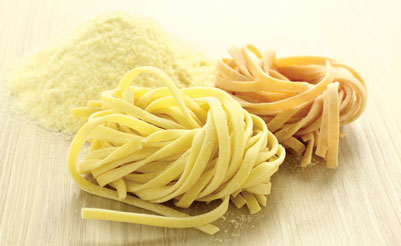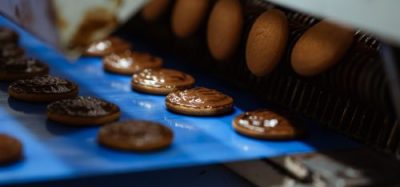Pasta extrusion: Conversion of semolina into pasta
- Like
- Digg
- Del
- Tumblr
- VKontakte
- Buffer
- Love This
- Odnoklassniki
- Meneame
- Blogger
- Amazon
- Yahoo Mail
- Gmail
- AOL
- Newsvine
- HackerNews
- Evernote
- MySpace
- Mail.ru
- Viadeo
- Line
- Comments
- Yummly
- SMS
- Viber
- Telegram
- Subscribe
- Skype
- Facebook Messenger
- Kakao
- LiveJournal
- Yammer
- Edgar
- Fintel
- Mix
- Instapaper
- Copy Link
Posted: 27 October 2014 | Frank A. Manthey and Elena de la Peña, North Dakota State University | No comments yet
Formation of gluten-based dough requires the presence of gluten proteins, gliadin and glutenin, moisture, and energy. Gliadin and glutenin proteins are storage proteins that accumulate in wheat endosperm cells during grain filling. Gliadins are a heterogenous group of single chain proteins that are responsible for dough cohesiveness. Gliadin proteins can be separated using electrophoresis into four groups: α-gliadins, β-gliadins, γ-gliadins, and ω-gliadins. α-Gliadins, β-gliadins, and γ-gliadins contain intrachain disulfide bonds, whereas ω-gliadins lack cysteine residues, a sulfur containing amino acid, and so cannot form disulfide bonds.


Gliadins are considered to be non-aggregating, meaning that their polymer chains do not interact to form large polymeric complexes. Glutenins are a heterogenous group of multichain proteins that are responsible for dough strength. Glutenin proteins can be classified into two groups: the high molecular weight glutenin subunit and the low molecular weight glutenin subunit. Glutenin proteins can form large polymeric protein complexes as a result of entanglements of long polymeric chains and their ability to form interchain disulfide bonds1.
Moisture is needed for dough formation. Gliadins and glutenins are packed very tightly in the protein bodies found in endosperm cells. As these proteins hydrate, they begin to expand, change their steric configuration, and expose reactive sites2. Thus, water acts as a plasticiser, increasing the intermolecular space and flexibility of gliadin and glutenin proteins allowing them the possibility of interacting with each other when the energy in the form of mixing/kneading is applied. Without mixing/kneading, the collision of glutenins and gliadins with each other will not take place. Mixing energy allows gliadins and glutenins interact with each other through disulfide bonds formed between their cysteine residues. The result of the simultaneous occurrence of gliadins and glutenins, moisture, and energy is the formation of a protein network that surrounds starch granules and provides the mechanical strength of pasta products.
Conversion of semolina into pasta
A pasta press is composed of an ingredient (semolina) feeding system, an ingredient hydration system (typically associated with a pre-mixer), a main mixer, and an extrusion barrel with an auger, extrusion head, and pasta die. Traditional pasta is made from semolina, the coarsely ground endosperm of durum wheat. Warm water (35 to 40°C) is sprayed onto the semolina in the pre-mixer. Enough water is added to bring the moisture content of the semolina to 30-32 per cent. High speed pre-mixer is commonly used to rapidly and evenly coat the semolina particles with water. The wetted semolina is discharged into the main mixer. Most mixers contain two counter-rotating horizontal parallel shafts with paddles set so that they move the hydrating semolina toward the extrusion barrel. The transit time in the main mixer is 15-20 minutes. While in the main mixer, the moisture penetrates the semolina particles, hydrating the storage proteins, gliadins and glutenins, and wetting the starch granules. As these proteins hydrate they expand, they become more flexible and expose potential reactive or bonding sites necessary for gluten development. Little or no dough formation occurs in the main mixer since there is not enough energy being applied to the hydrated semolina.
Most dry pasta manufacturers apply a vacuum (-63 to -80 kPa) either at the mixer or just before the extrusion barrel. Vacuum promotes hydration by eliminating surface tension associated with air. Vacuum also prevents air from being trapped inside the developing dough. Air trapped inside the extruded pasta will appear as a series of very fine bubbles resulting in a hazy appearance. If dried at high or ultrahigh temperatures, these bubbles will act as focal points for stress and could ultimately result in checking of the finished pasta.
The hydrated semolina is then directly discharged onto the rotating auger located inside the extrusion barrel. Traditionally, extrusion augers used in pasta processing have a length to diameter ratio between 6:1 and 9:1 and are configured with a constant root diameter and deep flights having a uniform pitch the entire length of auger. The dough is conveyed in the channel between flights on the auger; however, the flow of dough is not uniform in the channel. Dough near the root of the auger moves much more slowly than the material near the cylindrical barrel wall. Deep flights provide high conveying capacity and allow high back pressure flow in the auger.
The extrusion auger is surrounded by a water jacketed barrel. Warm water is rapidly circulated through the water jacket to dissipate excess heat generated by friction between the developing dough and the inner surface of the extrusion barrel. Friction is necessary for conveyance of the hydrated material on the auger. Without friction, the auger would turn and the hydrated mass of semolina would remain stationary relative to the auger. To have proper conveyance of the dough, the friction associated with the barrel must be greater than the friction associated with the auger. Longitudinal grooves are machined along the inner surface of the extrusion barrel to enhance the friction between the developing dough and the barrel. To reduce friction between the developing dough and the auger, the auger surface is made of polished stainless or chrome-plated steel.
A pressure gradient is formed as the hydrated material moves along the auger3. This pressure gradient is initially formed due to the compaction of the dough against the kneading plate that is located at the end of the auger. The material that is being pressed against the kneading plate is composed of many layers of highly compressed but not homogenous dough (Figure 1). This supports observations of other researchers that have indicated that almost no mixing/kneading takes place in the channel of the extrusion auger4. Observation of the hydrated semolina at different points along the length of the auger suggests that as pressure increases, the hydrated semolina transitions from a granular material at the beginning of the auger into a highly-compacted but not well developed dough at the end of the auger (Figure 2). Sometimes a cut-flight is added at the end of the auger to provide increased work or mixing action before the dough passes through a kneading plate3.
Significant dough development occurs when the compressed dough goes through the kneading plate (Figure 3). The kneading plate is a perforated plate that is situated between the end of the auger and the extrusion head. The dough is kneaded by the shearing forces that occur as it passes through the holes in the kneading plate. The kneading plate splits the dough into streams that recombine on the other side of the plate. After passing through the kneading plate, the gluten matrix is much more continuous and starch granules are clearly aligned along the direction of flow. Once the dough has entered the extrusion head the pressure increases even more due to flow restriction generated by the presence of screens (Figure 4) that are adjacent to the die and by the die itself (Figure 5). These adjacent screens function to protect the die from abrasive material and provide additional kneading to the dough. A combination of compression and shearing forces work the dough at this stage. Ultimately, the dough passes through the orifices in the extrusion die. The characteristic of the orifice determines the shape of the extruded pasta. At this stage the dough is as developed as it is going to get by the extrusion process.
There is evidence that the gluten network in pasta dough is not fully developed even after the extrusion; however, that does not imply that the extruded product does not have a solid and homogeneous structure. Matsuo et al5 concluded that low moisture content of pasta dough is not enough to fully hydrate the gluten proteins. This lack of moisture prevents the formation of the type of fully developed dough observed in bread baking.
In conclusion, pasta dough development within the extrusion barrel seems to be limited to the compression forces that occur toward the end of the extrusion auger. The majority of the dough development takes place by the shearing forces generated as the dough flows through a kneading plate, screens and the extrusion die and by the compression forces generated at the end of auger and inside the extrusion head.
References
- Veraverbeke, WS, Delcour, JA (2002) Wheat protein composition and properties of wheat glutenin in relation to breadmaking functionality. Crit Rev Food Sci Nutr. 42(3):179-208.
- Bernardin, JE, Kasarda, DD (1973) Hydrated protein fibrils from wheat endosperm. Cereal Chem. 50(5):529-36.
- Abecassis, J, Abbou, R, Chaurand, M, Morel, M-H, Vernoux, P (1994) Influence of extrusion conditions on extrusion speed, temperature, and pressure in the extruder and on pasta quality. Cereal Chem. 71(3):247-53.
- Sarghini, F, Cavella, S, Torrieri, E, Masi, P (2005) Experimental analysis of mass transport and mixing in a single screw extruder for semolina dough. J Food Engineering 68:497-503.
- Matsuo, RR, Dexter, JE, Dronzek, BL (1978) Scanning electron microscopy study of spaghetti processing. Cereal Chem. 55(5):744-53.
About the authors
Frank A. Manthey is a Professor in the Department of Plant Sciences at North Dakota State University, USA, where he has been the research leader for the Durum Wheat Quality/Pasta Processing Laboratory since 1998.
Elena de la Peña is a PhD candidate in the Cereal Science Graduate programme at North Dakota State University. She is originally from Burgos, Spain. Her dissertation topic is ‘Manufacturing optimisation of non-traditional pasta products’.









